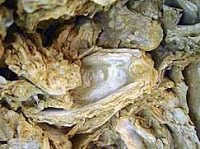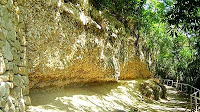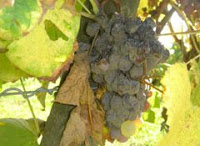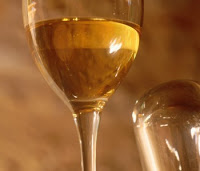 Sainte Croix du Mont is a little appellation which lies next to Loupiac, facing Sauternes and Barsac, where the Garonne and Ciron rivers meet. Sainte Croix du Mont is endowed with one of nature’s strange wonders. It lies upon a panoramic plateau comprised of vast fossilized oyster beds which give it an exceptional terroir. Certain châteaux have large, impressive wine cellars which have been hewed directly from this enormous layer of oysters which is several metres thick and the wine caves at the foot of the 12th century Château de Tastes, overlooking the Garonne Valley; have been adapted as a location for tasting the wines of the appellation.
Sainte Croix du Mont is a little appellation which lies next to Loupiac, facing Sauternes and Barsac, where the Garonne and Ciron rivers meet. Sainte Croix du Mont is endowed with one of nature’s strange wonders. It lies upon a panoramic plateau comprised of vast fossilized oyster beds which give it an exceptional terroir. Certain châteaux have large, impressive wine cellars which have been hewed directly from this enormous layer of oysters which is several metres thick and the wine caves at the foot of the 12th century Château de Tastes, overlooking the Garonne Valley; have been adapted as a location for tasting the wines of the appellation.
The legendary oyster bed of Sainte Croix du Mont can be seen along the natural wall found below the church and château. This remarkable geological layer was formed by a tremendous accumulation of shells 20 million years ago. They are all the same type of oyster: Alectryonia aquitanica and as the shells are closed and densely packed geologists have suggested that it is a fossilised oyster reef.
 Generally, when aquatic bivalve molluscs die, the muscles which command the opening and closure of their “cover” slacken and sea currents rapidly separate the two shells. This was not the case for the majority of the Sainte Croix du Mont oysters, hence the assumption that the oysters actually grew here.
Generally, when aquatic bivalve molluscs die, the muscles which command the opening and closure of their “cover” slacken and sea currents rapidly separate the two shells. This was not the case for the majority of the Sainte Croix du Mont oysters, hence the assumption that the oysters actually grew here.
 The 460 hectares of vineyards lie on the sometimes steep hillsides with their massive outcroppings of pure limestone. The grapes are affected by botrytis cinera (noble rot) and their slow ripening in autumn is aided by an absence of thunderstorms, which follow a more northerly track. The wines are not as full-bodied and intense as the best Sauternes and Barsacs but are fresher, more airy and livelier. They are deep gold in colour and have aromas of barley sugar, raisins, fig, acacia, honeysuckle, pineapple, apricot and peach. They are powerful, complex and inten se with a long finish.
The 460 hectares of vineyards lie on the sometimes steep hillsides with their massive outcroppings of pure limestone. The grapes are affected by botrytis cinera (noble rot) and their slow ripening in autumn is aided by an absence of thunderstorms, which follow a more northerly track. The wines are not as full-bodied and intense as the best Sauternes and Barsacs but are fresher, more airy and livelier. They are deep gold in colour and have aromas of barley sugar, raisins, fig, acacia, honeysuckle, pineapple, apricot and peach. They are powerful, complex and inten se with a long finish.
 As with all great dessert wines of the region, they have a good potential for ageing and the best châteaux can rival the quality of some Sauternes. However, as these wines are hard to find and are somewhat eclipsed by their prestigious neighbours they are a real bargain.
As with all great dessert wines of the region, they have a good potential for ageing and the best châteaux can rival the quality of some Sauternes. However, as these wines are hard to find and are somewhat eclipsed by their prestigious neighbours they are a real bargain.
 Well-known producers include Châteaux Bel Air, du Mont, La Grave, Loubens, La Rame and Lousteau-Vieil. The best Châteaux, such as Château La Rame and Château La Grave, can be compared to Sauternes, not just because they use the same grapes and are the product of noble rot in the best vintages, but because they also have the ambition and meticulous attention to detail, such as endless passes through the vineyards, picking by hand the few suitable berries over periods of weeks.
Well-known producers include Châteaux Bel Air, du Mont, La Grave, Loubens, La Rame and Lousteau-Vieil. The best Châteaux, such as Château La Rame and Château La Grave, can be compared to Sauternes, not just because they use the same grapes and are the product of noble rot in the best vintages, but because they also have the ambition and meticulous attention to detail, such as endless passes through the vineyards, picking by hand the few suitable berries over periods of weeks.
Sainte Croix de Mont has been growing grapes and making wine since Roman times. Since the time of Gaul’s conquest by Julius Caesar and until 471, the Romans occupied this region and set about improving the quality of fertile lands found in proximity to the Garonne river; they cleared the hillsides and planted the very first vines. Wealthy patricians came to settle in this welcoming countryside next to Sainte Croix du Mont and in the village itself, relics of a Gallo-Roman sepulchre have also been discovered.
 During the 12th century, the English constructed a fortress overlooking the valley: Château de Tastes. Throughout the entire period of English supremacy, and despite constant conflicts between the French and English, the wine producing towns of this area became wealthy and enjoyed the advantage of considerable autonomy and generosity bestowed by the Kings.
During the 12th century, the English constructed a fortress overlooking the valley: Château de Tastes. Throughout the entire period of English supremacy, and despite constant conflicts between the French and English, the wine producing towns of this area became wealthy and enjoyed the advantage of considerable autonomy and generosity bestowed by the Kings.
 To a greater extent than the French, the English valued the wines produced on Sainte Croix du Mont ’s hillsides. In 1316, the King of England abolished the duties deducted on wine sales and granted exemptions for “wines produced in the districts and jurisdictions of Sainte Croix du Mont.” This heralded a marvellous period for commerce and the success of wine merchants. Commercial navigation on the Garonne river was at its height. At the port of Sainte Croix du Mont, barrels of wine were loaded onto barges bound for England.
To a greater extent than the French, the English valued the wines produced on Sainte Croix du Mont ’s hillsides. In 1316, the King of England abolished the duties deducted on wine sales and granted exemptions for “wines produced in the districts and jurisdictions of Sainte Croix du Mont.” This heralded a marvellous period for commerce and the success of wine merchants. Commercial navigation on the Garonne river was at its height. At the port of Sainte Croix du Mont, barrels of wine were loaded onto barges bound for England.
 Sainte Croix du Mont is not without its historical figures – Pierre de Lancre, councillor at the Parliament of Bordeaux, once owned Château Loubens. De Lancre was the infamous judge who conducted a massive witch hunt in 1609 and is thought to have interrogated, tortured and killed more than 500 witches in Labourd. His published works have provided the basis for various treatises on demonology in modern times. He received King Louis XIII at his château and Cardinal Richelieu celebrated mass in the small troglodyte chapel there which is dug out directly from the fossilised oyster bed.
Sainte Croix du Mont is not without its historical figures – Pierre de Lancre, councillor at the Parliament of Bordeaux, once owned Château Loubens. De Lancre was the infamous judge who conducted a massive witch hunt in 1609 and is thought to have interrogated, tortured and killed more than 500 witches in Labourd. His published works have provided the basis for various treatises on demonology in modern times. He received King Louis XIII at his château and Cardinal Richelieu celebrated mass in the small troglodyte chapel there which is dug out directly from the fossilised oyster bed.
Vestiges of the 18th century are still visible too; it was an era when members of the Bordeaux bourgeoisie, charmed by the beauty of this area, came to settle here and built elegant mansions surrounded by their vineyards.
It’s a remarkable appellation which surprisingly seems to have slipped through the net – unless you have insider knowledge – and is well worth seeking out.
